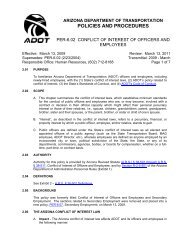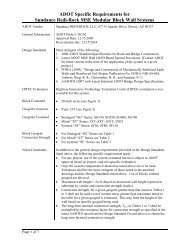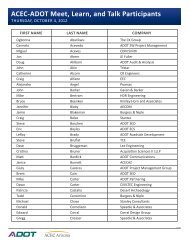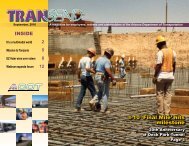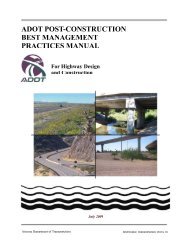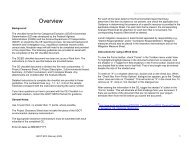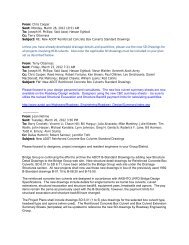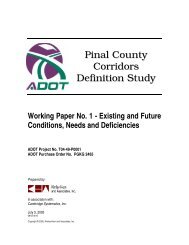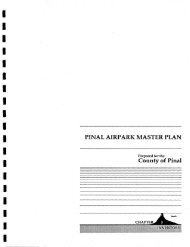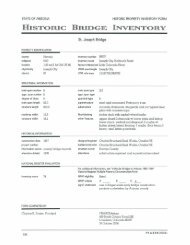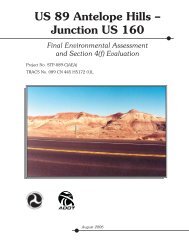I-10 Twin Peaks Traffic Interchange, Environmental Assessment
I-10 Twin Peaks Traffic Interchange, Environmental Assessment
I-10 Twin Peaks Traffic Interchange, Environmental Assessment
You also want an ePaper? Increase the reach of your titles
YUMPU automatically turns print PDFs into web optimized ePapers that Google loves.
Affected Environment and <strong>Environmental</strong> Impacts October 2005<br />
Grabe series soils consist of well-drained loams, gravelly loams, and silty clay<br />
loams. These soils form in recent alluvium deposited in flood plains, alluvial fans,<br />
and valley slopes. Slopes range from zero to three percent. Permeability of these<br />
soils is rapid and the hazard of erosion is slight. Grabe gravelly sandy loams are<br />
generally found in the alluvial fans of the Santa Cruz River Valley.<br />
Impacts<br />
No Build Alternative<br />
The no build alternative would have no effects on soils in the project area.<br />
Preferred Alternative<br />
During construction, disturbed soils in the project area would be vulnerable to<br />
erosion. This is especially true for soils that are highly susceptible to erosion by<br />
water or wind. According to the soil survey, soils present in the project area have a<br />
slight to moderate hazard of erosion. Prior to construction, a Storm Water<br />
Pollution Prevention Plan (SWPPP) and Dust Control Plan would be developed<br />
and implemented. Management practices contained in these plans would minimize<br />
soil erosion from stormwater runoff and wind as a result of the preferred action.<br />
Mitigation<br />
The SWPPP, which is discussed in detail in the National Pollutant Discharge<br />
Elimination System (NPDES)/Arizona Pollution Discharge Elimination System<br />
(AZPDES) Section entitled NPDES/AZPDES/SWPPP (page 4-21), would outline<br />
the implementation sequence of erosion and sediment control measures. These<br />
may include stabilization practices, structural controls, storm water management<br />
measures, and best management practices to mitigate the water erosion of soils. In<br />
addition, an activity permit from the Pima County Department of <strong>Environmental</strong><br />
Quality and a grading permit from the Town of Marana would be obtained to limit<br />
the amount of dust generated from construction activities (see Air Quality Section,<br />
page 4-45).<br />
Geologic Setting and Mineral Resources<br />
Existing Conditions<br />
Regional Geology<br />
The project site is located within the Tucson basin, which is a sub-area of the<br />
Upper Santa Cruz River drainage basin (Davidson 1973, Anderson 1987). The<br />
Tucson basin is a structural depression within the Basin and Range physiographic<br />
province. The basin is filled with sediments and generally trends north to<br />
northwest. The Town of Marana, and this project, is located in the northwestern<br />
part of the basin.<br />
The primary formations of interest for this project are, in descending order, the<br />
Fort Lowell Formation and the Upper Tinaja Beds. Both the Fort Lowell<br />
Formation and the Tinaja beds were developed as a result of sedimentation in a<br />
Interstate <strong>10</strong> <strong>Traffic</strong> <strong>Interchange</strong> at<br />
<strong>Twin</strong> <strong>Peaks</strong>/Linda Vista<br />
4-6<br />
Project No.: NH-0<strong>10</strong>-D (AIW)<br />
TRACS No.: <strong>10</strong> PM 236 H5838 01D



